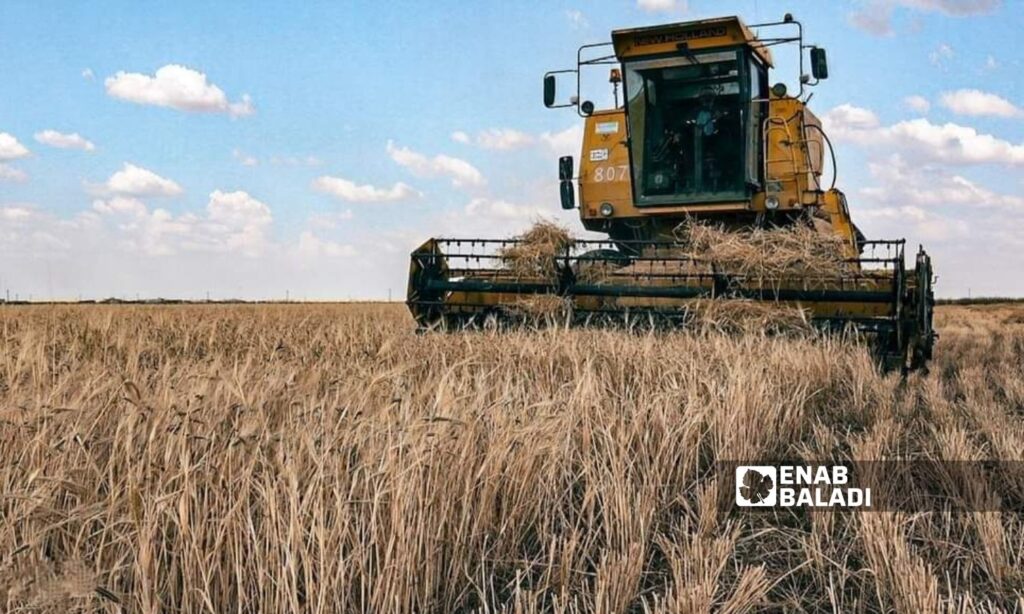As harvest season approaches, farmers in the city of Ras al-Ain in northwestern al-Hasakah express increasing concerns about the insufficiency of mechanical harvesters and the spiking rental costs in this primarily agricultural area.
These concerns are renewed every year. In the 2023 season, the rental cost of a harvester rose just days before the season started, forcing farmers to pay higher expenses, which were then between 6 and 8 US dollars per dunam.
At the mercy of harvester owners
Each year, farmers demand more harvesters to maintain the quality of their wheat and barley crops. Delays in harvesting can be detrimental; high temperatures may cause the plants to break and the grains inside them to spoil, resulting in crop loss.
Moreover, farmers are worried about the recurring fires in agricultural areas, which compel them to pay high harvester rentals, leaving them “at the mercy” of the harvester owners, according to farmers interviewed by Enab Baladi.
Marai al-Salim, a farmer for 25 years in al-Aziziya village west of Ras al-Ain, said the scarcity of harvesters and harvesting delays create fears among him and other farmers of crop damage or fires due to rising temperatures.
He added to Enab Baladi that the scarcity and aging condition of the harvesters in Ras al-Ain complicate the harvesting process further.
He highlighted the need for cooperation between local authorities and the Syrian Interim Government (SIG) to find effective solutions to smoothly harvest and market this season’s crops at fair prices for farmers.
Farmer Hassan al-Aziz from Lawzhi village east of Ras al-Ain holds similar concerns, owning 60 dunams of wheat and 20 dunams of barley this year.
He recalled an incident from 2023 when a fire in a neighbor’s land spread to his agricultural land due to delayed harvesting, resulting in a loss of 25 dunams out of the 50 he had planted with wheat.
He noted that this year the situation seems more hazardous, given the fewer harvesters, most of which are old and in need of replacement.
High operational costs
Harvester owners face challenges not much different from those of the farmers. They endure high operational costs, from fuel shortages to the expenses of purchasing and maintaining spare parts.
Saif al-Din al-Mohammad, a harvester owner in Ras al-Ain, said that the harvesting wages will inevitably be higher than last year due to increased operational costs.
He shared with Enab Baladi that he has been operating a harvester for over 20 years. The current scarcity of harvesters has only occurred in recent years due to the geographic constraints of the area.
In 2023, al-Mohammad said his harvester harvested irrigated lands at a cost of 7 dollars per dunam and rain-fed lands at 8 dollars per dunam. Due to rising fuel costs and workers demanding higher wages, he will increase his charges to accommodate both workers and farmers this year.
He pointed out that the price of a barrel of diesel (220 liters) had risen to more than 150 US dollars, adding to the expense of spare parts, which had increased by 80% over 2023.
If fuels and spare parts were available at reasonable prices, it would naturally lead to a decrease in harvesting fees, he mentioned.
Decreased cultivation areas
Omar Hammoud, head of the Agriculture and Animal Wealth Office at the Local Council, told Enab Baladi that the area of land cultivated with wheat has decreased this year compared to 2023, amounting to 110,000 dunams, whereas it was about 400,000 dunams in 2023. This reduction is due to farmers looking for more profitable alternatives.
He explained that there are currently 70 effective harvesters in the area, which he considers sufficient for harvesting both wheat and barley.
He added that the local council holds regular meetings with farmers and harvester owners to reach a pricing agreement beneficial to both parties, noting that the council provides support to tractor owners in case fires erupt in agricultural lands.
Losses in wheat and cotton crops
During the 2023 wheat harvest season in Ras al-Ain, farmers complained about crop build-up because the Interim Government only received small quantities, making them vulnerable to traders’ monopolies and control over their crops. This situation, due to the lack of appropriate storage facilities and difficulties in maintaining crop quality, resulted in spoilage.
The Interim Government had set the purchase price for a ton of clean hard wheat of the first grade at $330, yet farmers could not sell hard wheat for more than $220 per ton and soft wheat for $150 per ton.
Furthermore, the Interim Government did not intervene in purchasing the cotton crop grown within its controlled areas, causing significant losses for farmers who had to lower their sales prices. The price per ton ranged between $500 and $550, whereas in 2022, it ranged between $750 and $800.
Ras al-Ain and Tel Abyad are located along the Turkish border and are controlled by the Turkish-backed Syrian National Army (SNA), while the fronts with the Syrian Democratic Forces (SDF) surround them. The Turkish border serves as their only outlet abroad.

